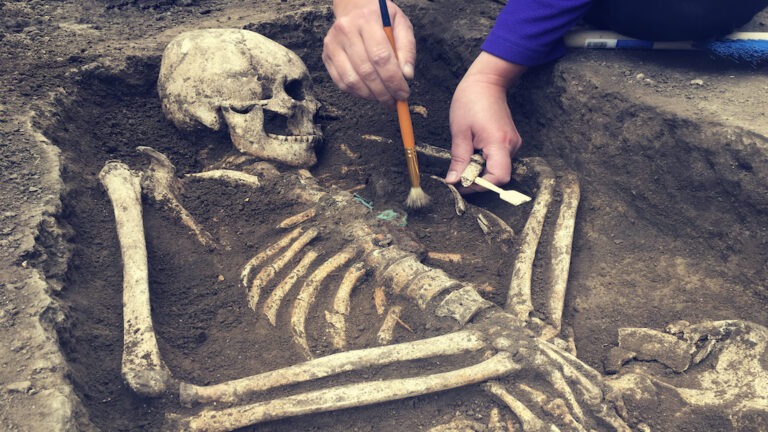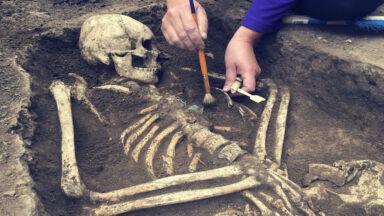The London Hammer: Is It An Out of Place Artifact?

What could be so unusual or controversial about the discovery of an iron hammer encased in ancient rock? After all, archaeologists have discovered historical artifacts for as long as humans have been searching for their ancient roots. But what happens when an object defies historical study and appears to exist as a kind of time traveler in the mysterious realms between worlds? For what is known as the “London Hammer,” the world has been wrangling with a seemingly ordinary household tool steeped in mystery, archaeological wonder, and with many unanswered questions.
Alleged to date back more than 400 million years, the London Hammer, or as it is also called the London Artifact, can be looked at as a study of how the modern and ancient worlds can connect and collide. How else can we explain that an obviously human-made instrument linked to the late 1800s that never rusted despite the wood transforming into coal?
How could the London Hammer withstand typical aging impacts like oxidation, and what explanations exist for its discovery in a rock formation predating human existence? Perhaps it’s best to begin with its claimed discovery location – the small town of London, Texas.
London Hammer — From Texas to the World Stage
For Max and Emma Hahn, it was a summer day like many others. In 1936, the Texas couple took a hike along Red Creek near London, Texas, a tiny community located in the center of the Lone Star State. But the hike turned out to be like no other the Hahns had ever experienced. Not because of the weather or the beauty of the landscape but because they discovered a strange piece of wood encased in what seemed to be an unusual formation of rock.
It wasn’t until 1947 that their son broke through the rock and uncovered what was attached to the wooden handle — an iron-headed hammer. For almost four decades, the hammer remained a local oddity and relatively unknown to those outside of London, Texas, until it came to the attention of Carl Baugh, a Young Earth creationist, after an article was published on the artifact in the Bible-Science Newsletter in 1983. Baugh was influential to a form of creationism that believes that Earth and all its forms of life were created by a deity’s supernatural acts 6000-10,000 years ago. He promoted the hammer as proof of an antediluvian discovery.
Of equal interest to archaeologists, the London Hammer posed a scientific dilemma. What theory could explain how a modern instrument was encased in ancient, prehistoric Ordovician rock from between 65-135 million years ago?
Many doubt where the hammer was supposedly found; skeptics claim the rock formation is consistent with the minerals and sediments of the surrounding area, putting the claim of the rock dating back to hundreds of millions of years ago in doubt. Others claim that the hammer could have been discarded and the rock formation occurred through the natural process of petrification.
Carbon 14 dating of the hammer’s wooden handle would provide a pathway to best determine the age of the rock and the hammer. Unfortunately, the hammer’s owner, Baugh, has only conducted private testing and has not yet shared any results publicly. The strongest criticism of Baugh’s pre-flood theory comes from Glen J. Kuban, former creationist, computer programmer, and paleontology enthusiast, who states that “no clear evidence linking the hammer to any ancient formation has been presented.”
Despite this, certain facts about the London Hammer do shed some light on the mysterious tool.
The Science Behind the Mystery
Objects such as the London Hammer are commonly referred to as Out of Place Artifacts, or OOParts, anomalous objects that bring into question geology, archeology, and the natural history of the Earth. The physical facts of London Hammer are as follows:
- The Hammer measures six inches in length with a diameter of one inch.
- The metal is made up of 96.6% iron, 2.6% chlorine, and 0.74% sulfur.
- The metal hammerhead has not rusted since it was discovered in the early 19th century.
- The wooden handle is unmineralized with small traces of carbonization
- While the exact discovery location has not been verified, the lack of sharp nicks seems to confirm that it was not chiseled from a larger rock formation but found loose, as the Hahns claimed.
Where Is The London Hammer Now?
As of today, the London Hammer is housed at the Creation Evidence Museum in Glen Rose, Texas. Founded in 1984 by Baugh, it is a non-profit educational museum funded solely by contributions. The objective of the Creation Evidence Museum is to investigate evidence and showcase exhibits that support Biblical creation. New artifacts and documents are regularly introduced into the museum’s collection, yet the London Hammer, still to this day, continues to be one of the most mysterious oddities on display.

Source: Wikipedia
The Mystery Continues — OOPart or Modern Era Tool?
There is much debate surrounding the London Hammer’s origin. Was the artifact hit by a meteorite that formed around the tool? According to what is known about the chemical composition of a meteor, the formation’s composition would seem to discount this theory. Some counter this by asserting the existence of an ancient, advanced civilization that left behind tools eerily similar to those of a more modern era.
The most well-known argument refuting the London Hammer’s provenance in an ancient time comes from J. R. Cole from the National Center for Science Education. He wrote in 1985 that “the stone concretion is real, and it looks impressive to someone unfamiliar with geological processes. How could a modern artifact be stuck in an Ordovician rock? The answer is that the concretion itself is not Ordovician. Minerals in solution can harden around an intrusive object dropped in a crack or simply left on the ground if the source rock (in this case, reportedly Ordovician) is chemically soluble.”
The American mystery surrounding the London Hammer remains. For those who believe, the hammer clearly represents an Out of Place Artifact or possibly a mystical time traveler. For others, it is a geological wonder. Whatever the belief, the London Hammer does represent our unquenchable thirst for knowledge, meaning, and connection to a larger order
Russian Defense Minister Sergei Shoigu Wants to Clone Scythian Army

The Russian military is reportedly looking to clone ancient warriors. Is it possible, and if so, why would they do it?
In the Siberian Republic of Tuva lie the remains of Scythian warriors and their horses buried for nearly 3,000 years. Now, Russia’s Defense Minister Sergei Shoigu apparently wants to put them back into action.
According to Ancient Origins, Shoigu has announced his desire to clone the 3,000-year-old soldiers telling the Russian Geographical Society, “Of course, we would like very much to find the organic matter and I believe you understand what would follow that. It would be possible to make something of it, if not Dolly the Sheep. In general, it will be very interesting.”
Dolly the Sheep refers to the first mammal ever cloned back in 1996. Now, a Russian-Swiss archeological team is reportedly searching for viable DNA from the graves to clone the ancient warriors. But many scientists are skeptical that this is even possible. No human has ever been cloned—that we know of…





































